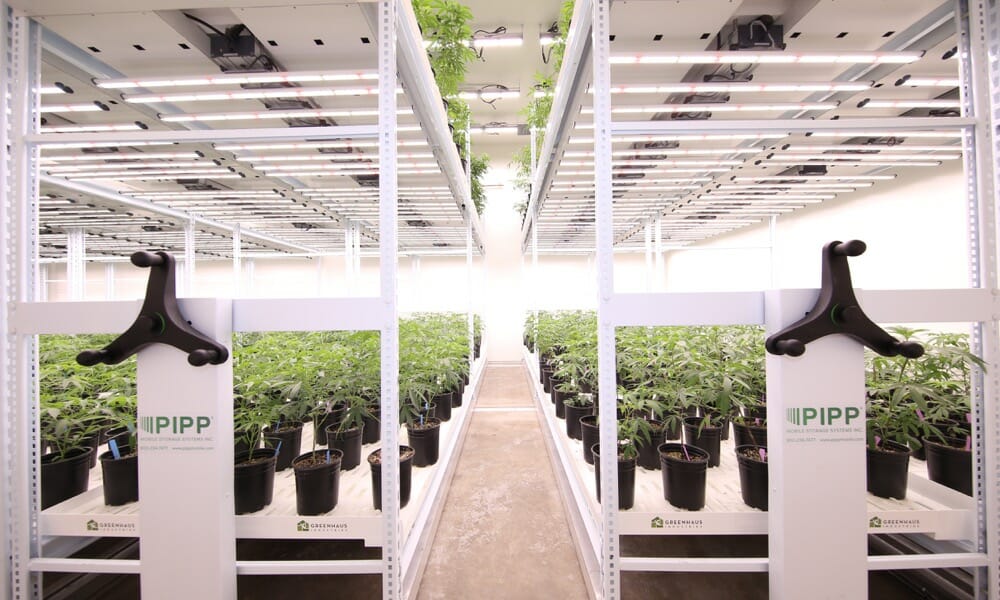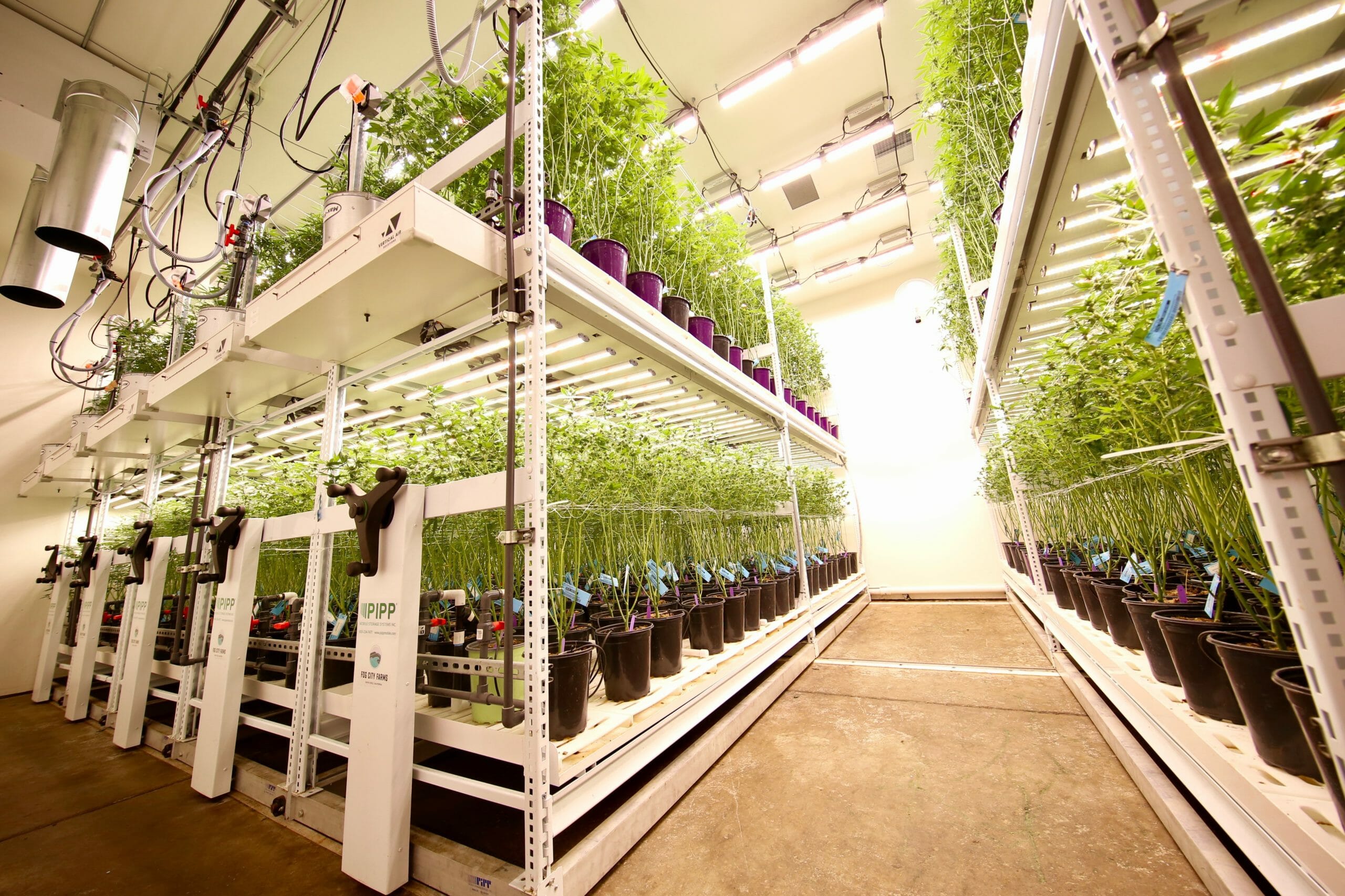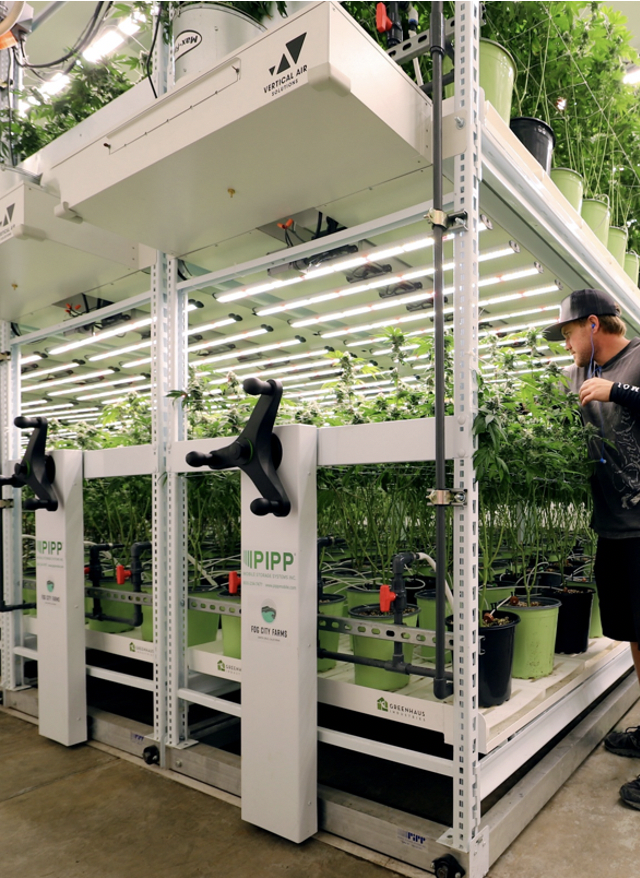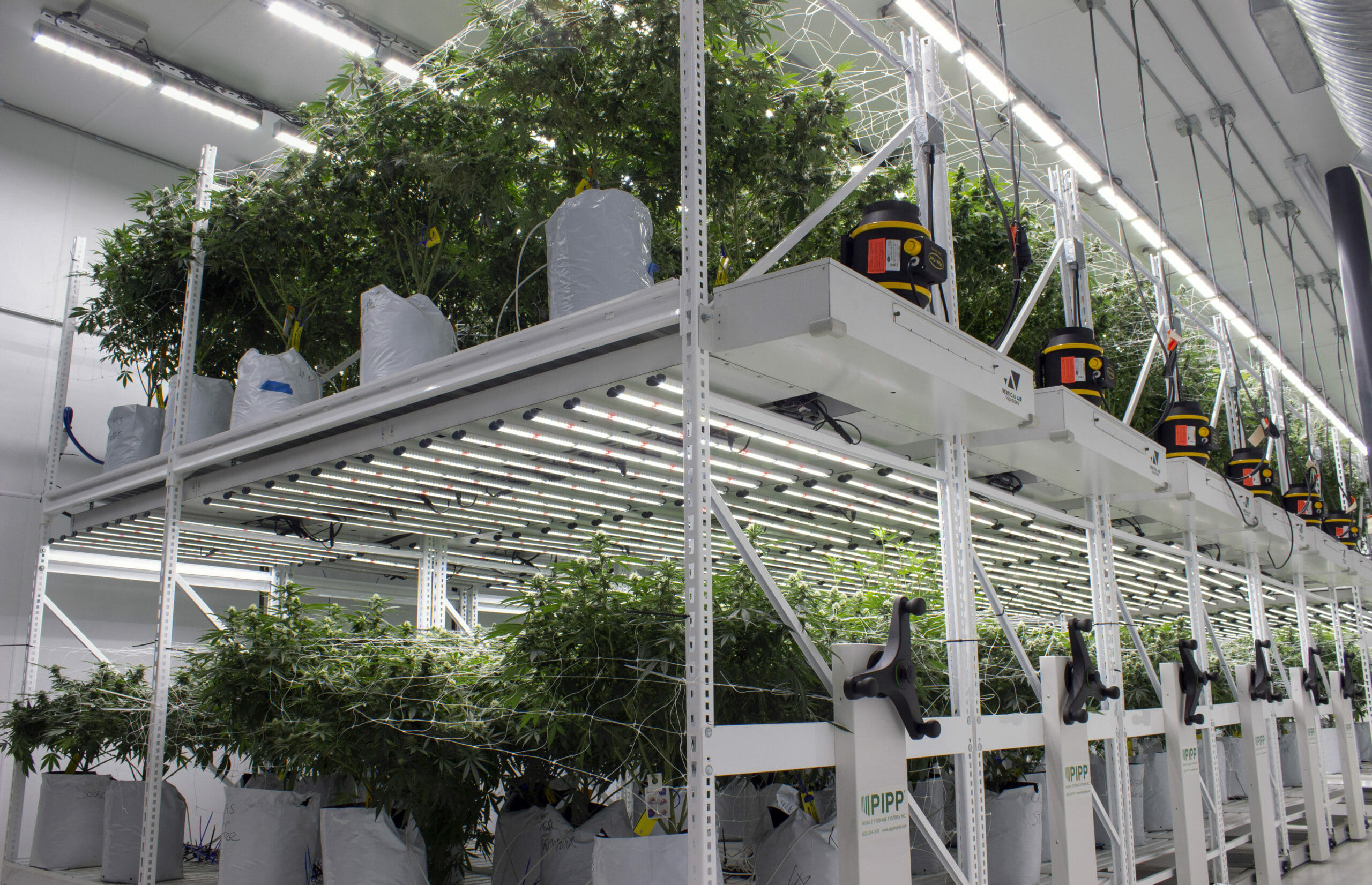
01 Mar Webinar: How to Make Vertical Work for You
Vertical farming in the cannabis industry is one of the most innovative and visually striking ways to make optimal use of space, but it isn’t for every grower.
In a recent webinar called Designing Your Own Vertical Farm, expert growers and system provider consultants from Pipp Horticulture, Vertical Air Solutions, and Fluence provided valuable insights into the realities of working in a vertical cannabis grow.

Fog City Farms in California is an innovator at the forefront of testing and applying vertical farming technologies to create a productive growing environment in one of the most expensive real estate states. Photo courtesy of Pipp Mobile Storage Systems Inc.
Designed for the Purpose of Growing
One of the most important factors in going with a vertical grow room is ensuring the facility is designed to maximize the available cubic space in the room while still providing an optimal environment for plant production. This means every aspect of the facility has been designed with climate, plant production space, workflow, sanitation, hygiene, and quality control in mind. While greenhouse and indoor growers in the controlled agriculture industry have spent decades perfecting their technique to optimize efficiencies, vertical farming at scale is a relatively new practice for commercial growers. Pioneers and manufacturers in the space have purposefully designed and built equipment to ensure it can perform well and not create unforeseen problems.
The webinar featured several leaders in the growing vertical farming segment who each brought their perspective on planning and equipment selection to consider when designing a vertical farm. From lighting and racking to the proper air flow, each piece of equipment plays an integral role in growers’ success or failures when growing at scale. When planning your vertical farm, it is imperative to select vendors who can effectively communicate and collaborate to ensure your facility is designed properly to achieve your cultivation and business goals

The experts in this webinar identified common problems that can occur when designing and planning a vertical farm. Growers and facility planners who are considering a vertical farm should be familiar with these common problems to avoid potential setbacks and ensure they are discussing proper facility design. For example, in a vertical farm, racks, trays, railings, and light fixtures are all possible obstacles to the flow of inputs and outputs throughout the room. If a tray is not designed to accommodate significant plant density, you may end up with drainage issues. The structural components of a racking system or light fixture need to be thought of as barriers that can potentially impede airflow through the plant canopy. In vertical farms, microclimates are more likely to appear if airflow, VPD, light intensity, and other environmental factors are not designed with a vertical farm in mind. Below is a list of common problems that could occur in multi-layer plant production. If you are considering a vertical farm for cannabis cultivation, tune into the on-demand webinar here to learn from the experts!
Identifying Common Problems
Growing vertically can often present unforeseen issues that can become problematic if you do not find the root cause. The panelists identified a few key issues that tend to crop up, and some of the most common reasons these issues appear:
- Photo-bleaching – High-intensity lighting needs to be introduced in small increments so as not to damage the chlorophyll in the leaves. Fluence recommends slowly increasing light intensity as your plant develops to ensure the success of healthy plant development and harvest
- Microclimates – Lack of horizontal airflow can cause humidity and transpiration issues that will stress your plants and make it easier for pests to gain a foothold. Vertical Air Solutions recommends ensuring airflow is distributed at multiple points throughout the canopy to minimize the effects of microclimates.
- Light uniformity – An advantage of using close proximity lighting in a vertical rack is the ability to ensure every plant receives high-intensity light throughout each layer of its canopy. However, when growing in proximity, it is important to understand light uniformity on your crops. Be sure to work with your lighting and racking to provider to visualize the anticipated light levels throughout the canopy as modeled in the racking system. If these calculations are done independently you run the risk of inaccurate light consistency on your plant canopy.
- Sanitation – Creating the proper amount of spacing between racks to ensure that each plant can be reached, and the workflow is efficient is key in maintaining sanitation standards. One trick is to use a bio-foamer so your staff can see what has just been cleaned. But using mobile racks designed to be moved so every inch of the grow room can be maintained and adjusted is another way to ensure you are discovering and properly addressing microclimates in a timely manner.
- Equipment integration – The main value of multi-layer farming is maximizing your cubic space of plant production. With this, it is important to select equipment that has seamless integration. For example, your lighting selection should have hardware that can fit into your racking, and your HVAC system should be installed to ensure consistent airflow. By selecting manufactures that integrate well with each other, you will achieve an optimal growing environment that maximizes production and minimizes any issues that could arise.
- Know your regulations – States vary in their plant production facility space regulations. If a state considered your building floor space as part of the plant production portion of your facility, consider adding a second or third layer to produce more product. There are creative ways to meet your state’s requirements and produce the most our of your space constraints.

How to Know Whether Vertical Is Right for You
One reason attending the live webinar is helpful is attendees’ ability to ask questions and receive answers in real-time, especially answers specific to your grow. Some of the more commonly asked questions about growing vertically include:
Q: How does growing vertically impact revenue?
A: There are two ways to evaluate the impact of your revenue. From a facility design perspective, by growing vertically you are doubling capacity and growing real estate in the same square footage, essentially doubling the space available for plant production. By growing vertically, Fog City Farms can potentially fit 80+ lights in the same square footage where only 30 legacy lighting solutions would fit before. An important aspect to keep in mind is the importance of quality in addition to yield. Most growers considering vertical deployments have grown under HPS lighting in a single-tiered environment. The space constraints for vertical farming require the adoption of LED technology. Growers who switch from HPS to broad-spectrum high light intensity LED have grown higher-yielding plants with more consistent THC, CBD and terpene levels. By growing under Fluence LEDs, growers are able to produce high-quality products that consumers want to buy.
Q: Knowing what you know about growing vertically today, what would you tell someone who is just getting into the market?
A: For facilities with smaller or limited spaces, close proximity growing is the way to go. With the right team, you can fit up to three tiers in a 14-foot space, but hiring consultants who know how to optimize your space is key. Once you’ve dialed your facility in, look to anticipate what people are looking for and tailor your genetics to address upcoming trends. From there, you can use your equipment to push the boundaries of your genetics and reap the rewards in terms of efficiency and production.
Q: Are there any rules of thumb when it comes to total plant capacity?
A: First, you need to check with your state regulations to make sure you are adhering to any plant count limitations. If your regulations do not define a plant capacity, then your room size and design will dictate your capacity. Regarding equipment, commercial racks you might construct with industrial supplies from a DIY store tend to be able to handle more than enough weight. If constructed properly, a rack should be able to handle more than 1,000 pounds per square foot. In terms of light intensity, the SPYDR Series can cover 16 square feet of plant canopy. On the other hand, the VYPR Series comes in 4×4 and 4×5 configurations, and can be configured to cast light efficiently from numerous heights. Once the lighting is set, how tightly you place the plants depends on the growing style you are looking to achieve. Growers typically configure their racks to handle about 36 plants per tray, or about .9–1 whole plant per square foot of the tray. But when cultivating with a sea of green method (no aisles in between plants), growers can get up to 64 smaller plants on one tray. One final thing to consider is that racks should not be longer than 56 feet, as workflow inefficiencies will develop as your growers walk around to maintain each of the plants.
To learn more, check out the Fluence webinar series, or view this particular webinar here. Alternatively, you can contact a Fluence sales representative to discuss how we can help you improve your business.


